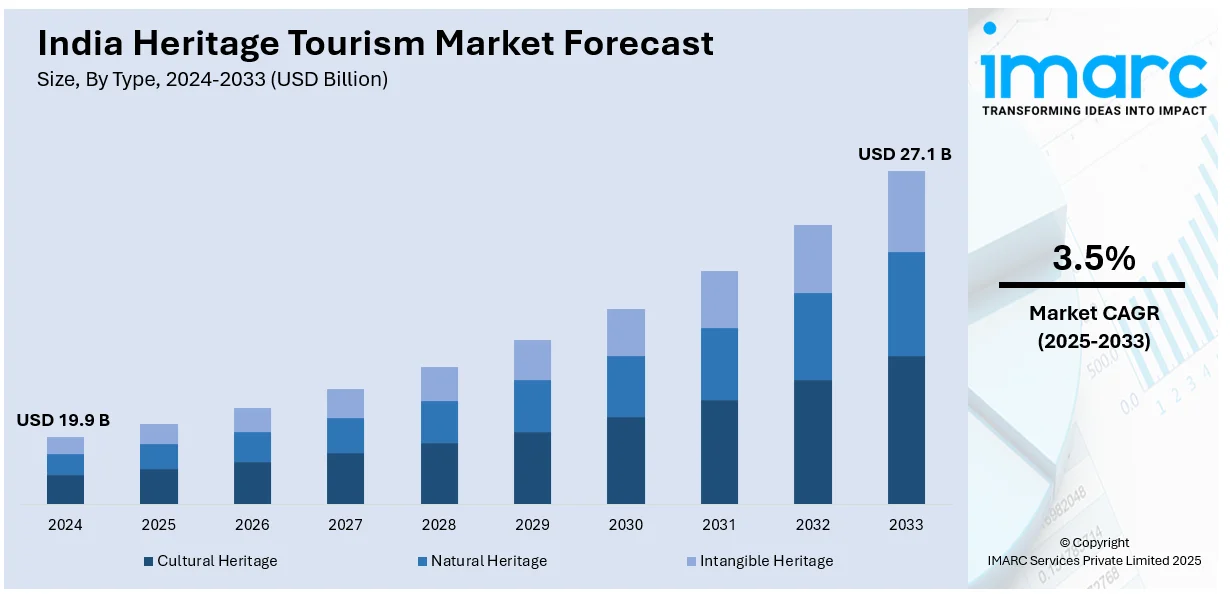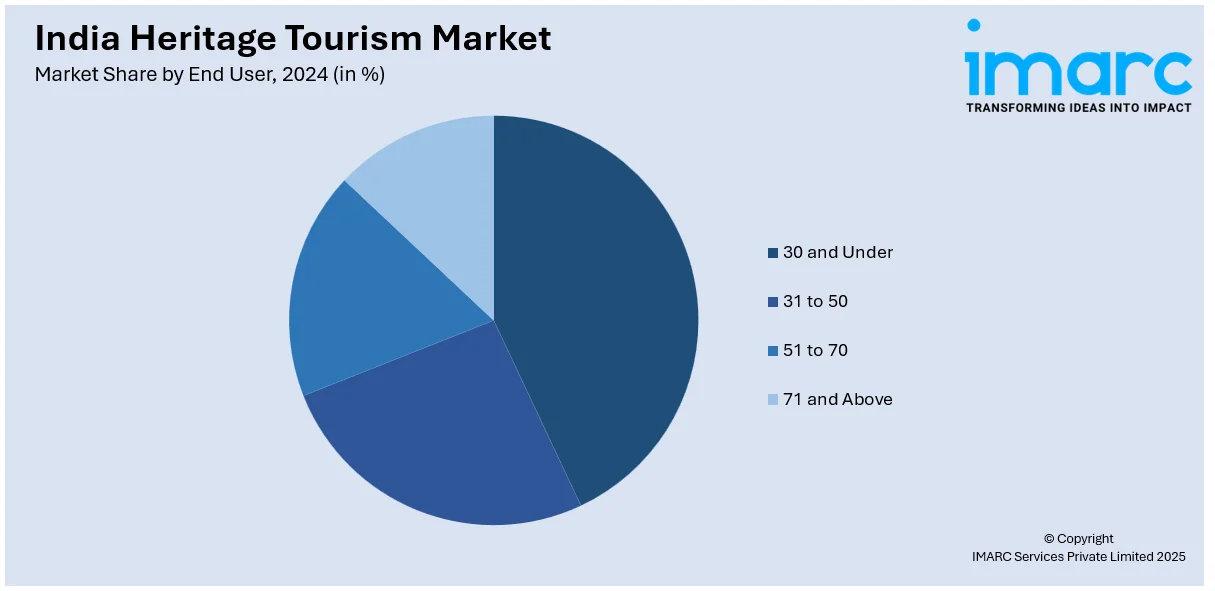
India Heritage Tourism Market Size, Share, Trends and Forecast by Type, Booking Channel, End User and Region, 2025-2033
India Heritage Tourism Market Overview:
The India heritage tourism market size reached USD 19.9 Billion in 2024. Looking forward, IMARC Group expects the market to reach USD 27.1 Billion by 2033, exhibiting a growth rate (CAGR) of 3.5% during 2025-2033. The market is spurred by increasing demand for cultural experiences, historic sites, and religious tourism. Government programs such as ‘Dekho Apna Desh’ and ‘Incredible India’ campaigns combined with increasing disposable incomes, global travel growth, and an eagerness to discover India's rich cultural heritage fuel the India heritage tourism market growth.
|
Report Attribute
|
Key Statistics
|
|---|---|
|
Base Year
|
2024
|
|
Forecast Years
|
2025-2033
|
|
Historical Years
|
2019-2024
|
| Market Size in 2024 | USD 19.9 Billion |
| Market Forecast in 2033 | USD 27.1 Billion |
| Market Growth Rate 2025-2033 | 3.5% |
India Heritage Tourism Market Trends:
Rise in Cultural and Spiritual Tourism
The increase in cultural and spiritual tourism is one of the major trends influencing the India heritage tourism market outlook. With people looking for authentic experiences, India's rich history, religious places, and myriad cultural traditions are attracting attention. The Chettinad Heritage and Cultural Festival, for instance, has certainly helped provide a livelihood for local artisans and businesses by generating around two million rupees every day. In addition, other forms of tourism include spiritual tourism, which is attracting both local and foreign visitors in pilgrimage tours to Varanasi, Amritsar, and Rishikesh. Even cultural programs such as Diwali, Durga Puja, and Holi attract travelers seeking to witness India's folk art, music, dance, and ceremonies. This trend is not only confined to the traditional pilgrimage but encompasses visitors looking for enhanced cultural experiences. This increasing emphasis on spiritual wellness and spiritual tourism opens up the heritage destinations in India for tourists to immerse in ancient culture and spirituality, thus emerging with a segment in tourism-the cultural and spiritual tourism market.

To get more information on this market, Request Sample
Growth of Eco-Friendly and Sustainable Heritage Tourism
Sustainability is one of the major trends in India's heritage tourism sector, with growing focus on eco-tourism practices. As environmental conservation consciousness grows, travelers are looking more and more for destinations that allow eco-friendly activities while maintaining cultural and historical heritage. That is the reason numerous hotels are making significant strides toward energy efficiency. As an illustration, the Taj Mahal Hotel in New Delhi has enhanced efficiency and attained energy savings equal to 149 metric tonnes of CO2 emissions by implementing IOT Automation provided by IOT Ecotech. This is equal to the growth of 2461 trees or the conservation of 75,000 kgs of coal from combustion. Heritage locations like Hampi, Khajuraho, and Rajasthan's forts are being marketed for their eco-tourism value, providing distinctive low-impact experiences. Efforts from the Indian government and tourism authorities are aimed at preserving heritage locations using sustainable tourism practices such as waste management, minimized carbon emissions, and ethical tourism. Eco-tourism is also involving the local community to a larger extent, where tourists get an opportunity to participate in activities such as traditional arts and crafts, organic farming, and cultural interaction. The focus on sustainable tourism, which is respectful to the environment as well as to the local culture, is transforming the heritage travel industry in India into an even more sustainable and moral option for mindful tourists.
Digitization and Virtual Heritage Tours
To meet the changing demands of new-age tourists, India's heritage tourism sector is experiencing a drift toward digitalization and virtual visits. As technology has progressed, virtual tours of India's monuments are enabling travelers to view its historical monuments at home. Virtual reality (VR) and augmented reality (AR) programs are taking heritage places such as the Taj Mahal, Red Fort, and Qutub Minar to international audiences in an interactive and immersive way. This phenomenon was particularly important in the context of the COVID-19 pandemic when travel restrictions meant there was increased demand for digital heritage experiences. Recently, the Maladevi Temple Virtual Tour Project was approved by the Department of Science and Technology for the Science and Heritage Research Initiative (SHREE) project. The department designated Rs 43.28 lakh across two years, representing the highest SHREE grant given to any MP university. The initiative integrates Metaverse technology, a blockchain-driven computing framework operating as a substitute for a virtual environment. Hence, digital media, apps, and websites are now providing virtual museum tours, live cultural event streaming, and digital exhibits to reach a global audience. As the technology keeps advancing, they present possibilities for enriching on-location experiences and developing an inclusive, accessible heritage tourism market, drawing technology-savvy tourists that want to discover India's past through innovative sites.
India Heritage Tourism Market Segmentation:
IMARC Group provides an analysis of the key trends in each segment of the market, along with forecasts at the regional level for 2025-2033. Our report has categorized the market based on type, booking channel, and end user.
Type Insights:
- Cultural Heritage
- Natural Heritage
- Intangible Heritage
The report has provided a detailed breakup and analysis of the market based on the type. This includes cultural heritage, natural heritage, and intangible heritage.
Booking Channel Insights:
- Online
- Offline
The report has provided a detailed breakup and analysis of the market based on the booking channel. This includes online, and offline.
End User Insights:

- 30 and Under
- 31 to 50
- 51 to 70
- 71 and Above
The report has provided a detailed breakup and analysis of the market based on the end user. This includes 30 and under, 31 to 50, 51 to 70, and 71 and above.
Regional Insights:
- North India
- South India
- East India
- West India
The report has also provided a comprehensive analysis of all the major regional markets, which include North India, South India, East India, and West India.
Competitive Landscape:
The market research report has also provided a comprehensive analysis of the competitive landscape. Competitive analysis such as market structure, key player positioning, top winning strategies, competitive dashboard, and company evaluation quadrant has been covered in the report. Also, detailed profiles of all major companies have been provided.
India Heritage Tourism Market News:
- In March 2025, the Directorate of Archaeology, Archives & Museums, Madhya Pradesh, has initiated a number of digital projects to improve public access to the state's rich cultural and archaeological heritage in a ground-breaking attempt to combine technology with heritage conservation.
India Heritage Tourism Market Report Coverage:
| Report Features | Details |
|---|---|
| Base Year of the Analysis | 2024 |
| Historical Period | 2019-2024 |
| Forecast Period | 2025-2033 |
| Units | Billion USD |
| Scope of the Report |
Exploration of Historical Trends and Market Outlook, Industry Catalysts and Challenges, Segment-Wise Historical and Future Market Assessment:
|
| Types Covered | Cultural Heritage, Natural Heritage, Intangible Heritage |
| Booking Channels Covered | Online, Offline |
| End Users Covered | 30 and under, 31 to 50, 51 to 70, 71 and Above |
| Regions Covered | North India, South India, East India, West India |
| Customization Scope | 10% Free Customization |
| Post-Sale Analyst Support | 10-12 Weeks |
| Delivery Format | PDF and Excel through Email (We can also provide the editable version of the report in PPT/Word format on special request) |
Key Benefits for Stakeholders:
- IMARC’s industry report offers a comprehensive quantitative analysis of various market segments, historical and current market trends, market forecasts, and dynamics of the India heritage tourism market from 2019-2033.
- The research report provides the latest information on the market drivers, challenges, and opportunities in the India heritage tourism market.
- Porter's five forces analysis assist stakeholders in assessing the impact of new entrants, competitive rivalry, supplier power, buyer power, and the threat of substitution. It helps stakeholders to analyze the level of competition within the India heritage tourism industry and its attractiveness.
- Competitive landscape allows stakeholders to understand their competitive environment and provides an insight into the current positions of key players in the market.
Key Questions Answered in This Report
The India heritage tourism market was valued at USD 19.9 Billion in 2024.
The heritage tourism market in India is projected to exhibit a CAGR of 3.5% during 2025-2033, reaching a value of USD 27.1 Billion by 2033.
The heritage tourism market in India is driven by growing cultural curiosity and authentic travel experiences, government initiatives like Swadesh Darshan and AdoptaHeritage, and private sector participation in site restoration and hospitality. Improved infrastructure, digital engagement (virtual/AR tours), and community-based programs further support sustainable heritage growth.
Need more help?
- Speak to our experienced analysts for insights on the current market scenarios.
- Include additional segments and countries to customize the report as per your requirement.
- Gain an unparalleled competitive advantage in your domain by understanding how to utilize the report and positively impacting your operations and revenue.
- For further assistance, please connect with our analysts.
 Request Customization
Request Customization
 Speak to an Analyst
Speak to an Analyst
 Request Brochure
Request Brochure
 Inquire Before Buying
Inquire Before Buying




.webp)




.webp)












